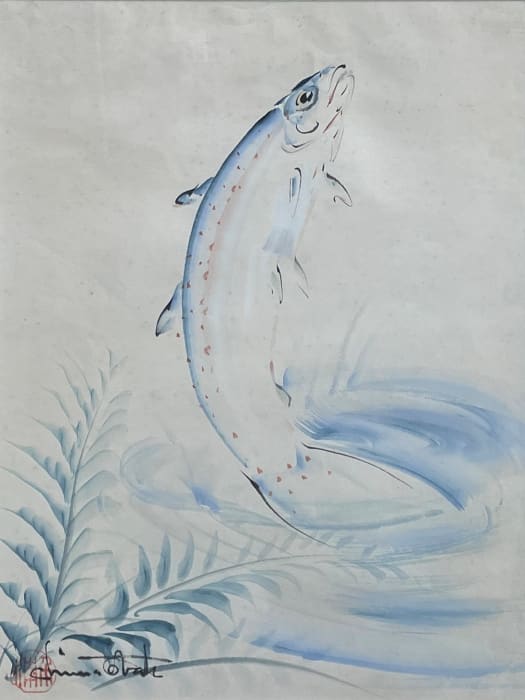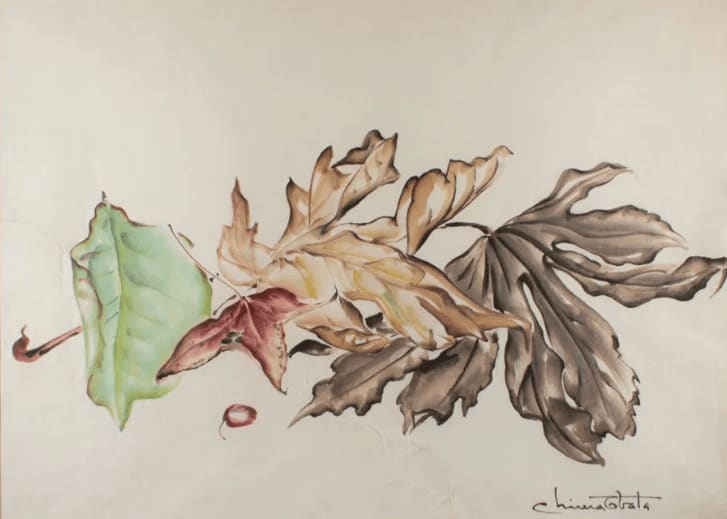Obata engaged with diverse practices, styles, and traditions, but most of all, he was a master of watercolor who combined dazzling technical facility with an understated lyricism. Without blindly following any particular art movement, he merged Japanese, European, and American aesthetics in a way that inspired U.S. artists and struck a chord with viewers. In addition, his compelling personal story as an immigrant in a xenophobic period remains as relevant today as in the twentieth century.
Obata was born in Okayama prefecture in Japan, the youngest of a large family. At age seven, he began formal training in the traditional art of sumi-e (Japanese ink and brush painting). However, he also studied European art history as well as modern Japanese styles, enabling him to paint in an eclectic sumi style throughout his long career.
For reasons that are not entirely clear, Obata emigrated to the United States in 1903 at age 17. He arrived in San Francisco just as a wave of anti-Japanese rhetoric and legislation made the United States particularly inhospitable for Japanese immigrants. Yet, paradoxically, this climate of intense hostility coexisted with the aesthetic admiration of Japanese culture known as Japonisme. Initially, Obata worked as a commercial decorator and an illustrator for Japanese-language newspapers and magazines. In 1906, he was present to make on-site sketches of the aftermath of the San Francisco earthquake.
During the 1920s, Obata increasingly focused on the California landscape. He traveled widely in the state—from Eureka in the north to Pasadena in the south—experimenting with a variety of stylistic and watercolor techniques. He generally simplified the forms of nature, rendering them with calligraphic brushstrokes and washes of color. By using the relatively new (to the United States) wet-on-wet watercolor technique, Obata could allow the paint to spread unpredictably and create beautiful bleeds between areas of color
In the summer of 1927, Obata spent six weeks on a sketching tour of Yosemite National Park and the Sierra Nevada high country. He produced more than 100 new sketches and ink paintings, and an exhibition of these works the following year drew the appreciation of an English-speaking audience. “This experience was the greatest harvest for my whole life and future in painting,” he later said. The woodblock prints he made from this trip in 1930 further enhanced his reputation and led to many successful one-man shows in California.
The California landscape became the greatest influence on Obata’s work. His painting was grounded in close observation but he eschewed a strictly realistic depiction. He would paint Yosemite Valley, the rocky California coastline, the towering Sierra, and the imposing redwood groves numerous times in his life. Although his landscapes were superficially allied with American Scene painting that flourished during the Great Depression, urban and industrial landscapes rarely appeared in his work. Nor did he venture to comment on the fraught world situation of the 1930s. The “grand nature of California,” he later said, “has always given me great lessons, comfort, and nourishment.”
In 1932, Obata was appointed as an art instructor at the University of California at Berkeley. There, Obata played a major role in introducing Japanese art techniques and aesthetics to other artists in California, especially painters associated with the movement known as the “California Watercolor School.” By the end of his career, he had instructed about 10,000 students and helped to elevate the status of watercolor painting in the United States.
The Japanese attack on Hawaii in 1941 completely disrupted Obata’s life. In February 1942, President Roosevelt signed Executive Order 9066, declaring that the exclusion of Japanese Americans from the west coast of the United States was a ‘military necessity.” Obata was among the 120,000 Japanese Americans to be imprisoned in incarceration camps during World War II. He was forced to close his art supply store, cancel all his classes, and rely on friends to store his paintings. In April 1942, Obata was relocated to the stables at the Tanforan Racetrack in San Bruno, CA, a holding area for about 8,000 Japanese Americans. In September 1942, Obata and his family were transferred to an internment camp in Topaz, a forlorn, hot, dusty site in central Utah. In both prison camps, Obata founded and directed art schools. He also created more than a hundred sketches, paintings, and prints during the period, using whatever materials came to hand.
Obata was released from confinement in 1943 and when World War II ended in 1945, he was reinstated at UC-Berkeley where he worked until his retirement in 1954. The same year, he became a naturalized U.S. citizen. After his retirement, he continued to paint and to lead tours to Japan to see gardens and art until his death at age 90.
Although often associated with the California Watercolor School, Obata’s style was always difficult to pin down. Of his obsession with nature, he later declared, “I paint nature not as if I were a classical, or a Cubist, or an Impressionist, but simply as I see her loveliness.”
In 1965 he received an order from the Japanese Emperor for promoting cultural exchange between the United States and Japan and was rewarded with a retrospective at the Smithsonian American Art Museum in Washington, D.C. in 2019.








